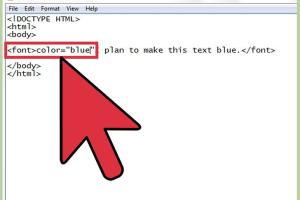Mastering Font Color Tags in HTML: A Comprehensive Guide for Web Designers

-
Quick Links:
- Introduction
- History of Font Color Tags
- Basic HTML Syntax for Font Color
- CSS Alternatives to Font Color Tags
- Best Practices for Using Font Color Tags
- Case Studies: Successful Implementations
- Common Mistakes to Avoid
- Conclusion
- FAQs
Introduction
The use of font color tags in HTML has been a cornerstone of web design for decades. While modern CSS has largely taken over styling responsibilities, understanding the fundamentals of HTML color tags remains crucial for both seasoned developers and newcomers. This guide delves into the usage, history, and best practices of font color tags, providing you with the knowledge to enhance your web projects effectively.
History of Font Color Tags
Font color tags were introduced in the early days of HTML as a way to quickly style text on web pages. The <font> tag allowed developers to specify colors directly within HTML documents, enabling vibrant and visually engaging websites. However, with the advent of CSS, the <font> tag has become deprecated in favor of more semantic and flexible styling options.
Despite this shift, understanding these tags is still beneficial, especially when working with legacy code or in educational contexts.
Basic HTML Syntax for Font Color
The basic syntax of the font color tag is as follows:
<font color="color_value">Your Text Here</font>Where color_value can be specified in various formats, such as:
- Named colors (e.g., "red")
- Hex codes (e.g., "#FF0000")
- RGB values (e.g., "rgb(255,0,0)")
- RGBA values (e.g., "rgba(255,0,0,0.5)")
Example:
<font color="#FF5733">This is colored text</font>CSS Alternatives to Font Color Tags
While the font color tag is still functional, CSS provides a more powerful and flexible approach to styling text. Here’s how you can accomplish the same effect using CSS:
<span style="color: #FF5733">This is colored text</span>This method separates content from presentation, adhering to modern web standards and improving maintainability.
Best Practices for Using Font Color Tags
When using font color tags or CSS for styling text, consider the following best practices:
- Use CSS for all styling to ensure better maintainability.
- Choose color contrasts that enhance readability.
- Be mindful of accessibility; use tools to check color contrast ratios.
- Avoid overusing bright colors that can overwhelm the user.
- Maintain consistency with your color palette across the site.
Case Studies: Successful Implementations
Case Study 1: A Local Business Website
A local bakery utilized font color tags in their HTML to highlight promotional messages. By using different colors for announcements, they significantly increased visibility and customer engagement. However, they later transitioned to CSS to streamline their codebase and improve performance.
Case Study 2: Educational Portal
An educational platform used CSS for text color to differentiate between various sections. By implementing a consistent color scheme, they enhanced user experience and aided in content navigation.
Common Mistakes to Avoid
Here are some common pitfalls when using font color tags:
- Using obsolete tags like
<font>in modern web design. - Neglecting color contrast for readability.
- Overcomplicating color schemes, resulting in visual clutter.
Conclusion
Understanding how to use font color tags in HTML, even in a world dominated by CSS, is vital for web designers. By mastering both methods, you can create visually appealing and accessible web pages that resonate with your audience.
FAQs
1. What is the purpose of the font color tag in HTML?
The font color tag allows you to change the color of text directly within HTML documents.
2. Is the font color tag still relevant in modern web design?
While still functional, it's deprecated in favor of CSS, which offers more flexibility and maintainability.
3. How do I choose colors for my website?
Consider your brand identity, audience preferences, and ensure good contrast for readability.
4. What are CSS alternatives to font color tags?
You can use CSS properties like color within a span or div tag.
5. Can I use hex color codes in HTML color tags?
Yes, you can specify colors using hex codes in both font color tags and CSS.
6. Are there any accessibility considerations when choosing colors?
Yes, always ensure your text colors have sufficient contrast against the background for readability.
7. What happens if I don’t use the correct color format?
Using an incorrect format may result in the color not being displayed or defaulting to black.
8. Is it better to use inline styles or external stylesheets for color?
External stylesheets are generally preferred for maintainability and organization.
9. How can I test color contrast on my website?
You can use online tools like the WebAIM Color Contrast Checker to test your color combinations.
10. Will using too many colors confuse users?
Yes, overusing colors can create visual clutter and confuse users. Aim for a cohesive palette.
External References
- W3Schools - HTML Colors
- WebAIM - Color Contrast Checker
- Smashing Magazine - Accessible Color Schemes
- FreeCodeCamp - CSS Color Properties
Random Reads
- How to set up your nintendo wii
- Fix full screen command prompt
- Fix google play store error
- How to reset security questions in yahoo mail
- How to reset samsung phone or tablet
- How to build saunas
- How to build throne minecraft
- How to copy a table from a pdf to excel
- How to block cookies
- How to block calls on messenger